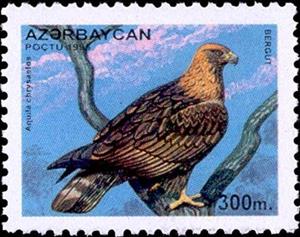Stamp: Golden Eagle (Aquila chrysaetos) (Azerbaijan 1995)
Golden Eagle (Aquila chrysaetos) (Azerbaijan 1995)
30 November (Azerbaijan ) within release Definitive issue.Flora and Fauna goes into circulation Stamp Golden Eagle (Aquila chrysaetos) face value 300 Azerbaijani manat
| Stamp Golden Eagle (Aquila chrysaetos) in catalogues | |
|---|---|
| Michel: | Mi:AZ 272 |
| Stamp Number: | Sn:AZ 542 |
| Yvert et Tellier: | Yt:AZ 246 |
Stamp is horizontal format.
Also in the issue Definitive issue.Flora and Fauna:
- Stamp - Karabakh Horse (Equus ferus caballus) face value 100;
- Stamp - Muscari elecostomum face value 200;
- Stamp - Beluga (Huso huso) face value 250;
- Stamp - Golden Eagle (Aquila chrysaetos) face value 300;
- Stamp - Caspian Tiger (Panthera tigris virgata) face value 400;
- Stamp - Caucasian Grouse (Lyrurus mlokosiewiczi) - Female face value 500;
- Stamp - Caucasian Grouse (Lyrurus mlokosiewiczi) - Male face value 1000;
Stamp Golden Eagle (Aquila chrysaetos) it reflects the thematic directions:
Mammals are any vertebrates within the class Mammalia (/məˈmeɪli.ə/ from Latin mamma "breast"), a clade of endothermic amniotes distinguished from reptiles (including birds) by the possession of a neocortex (a region of the brain), hair, three middle ear bones and mammary glands. All female mammals nurse their young with milk, secreted from the mammary glands. Mammals include the largest animals on the planet, the great whales. The basic body type is a terrestrial quadruped, but some mammals are adapted for life at sea, in the air, in trees, underground or on two legs. The largest group of mammals, the placentals, have a placenta, which enables the feeding of the fetus during gestation. Mammals range in size from the 30–40 mm (1.2–1.6 in) bumblebee bat to the 30-meter (98 ft) blue whale. With the exception of the five species of monotreme (egg-laying mammals), all modern mammals give birth to live young. Most mammals, including the six most species-rich orders, belong to the placental group. The largest orders are the rodents, bats and Soricomorpha (shrews and allies). The next three biggest orders, depending on the biological classification scheme used, are the Primates (apes and monkeys), the Cetartiodactyla (whales and even-toed ungulates), and the Carnivora (cats, dogs, seals, and allies).
Birds of prey or predatory birds, also known as raptors, are hypercarnivorous bird species that actively hunt and feed on other vertebrates (mainly mammals, reptiles and smaller birds). In addition to speed and strength, these predators have keen eyesight for detecting prey from a distance or during flight, strong feet with sharp talons for grasping or killing prey, and powerful, curved beaks for tearing off flesh. Although predatory birds primarily hunt live prey, many species (such as fish eagles, vultures and condors) also scavenge and eat carrion
Eagle is the common name for the golden eagle, bald eagle, and other birds of prey in the family Accipitridae. Eagles belong to several groups of genera, some of which are closely related. True eagles comprise the genus Aquila. Most of the 68 species of eagles are from Eurasia and Africa. Outside this area, just 14 species can be found—two in North America, nine in Central and South America, and three in Australia.
Animals are multicellular, eukaryotic organisms of the kingdom Animalia (also called Metazoa). All animals are motile, meaning they can move spontaneously and independently, at some point in their lives. Their body plan eventually becomes fixed as they develop, although some undergo a process of metamorphosis later on in their lives. All animals are heterotrophs: they must ingest other organisms or their products for sustenance.




